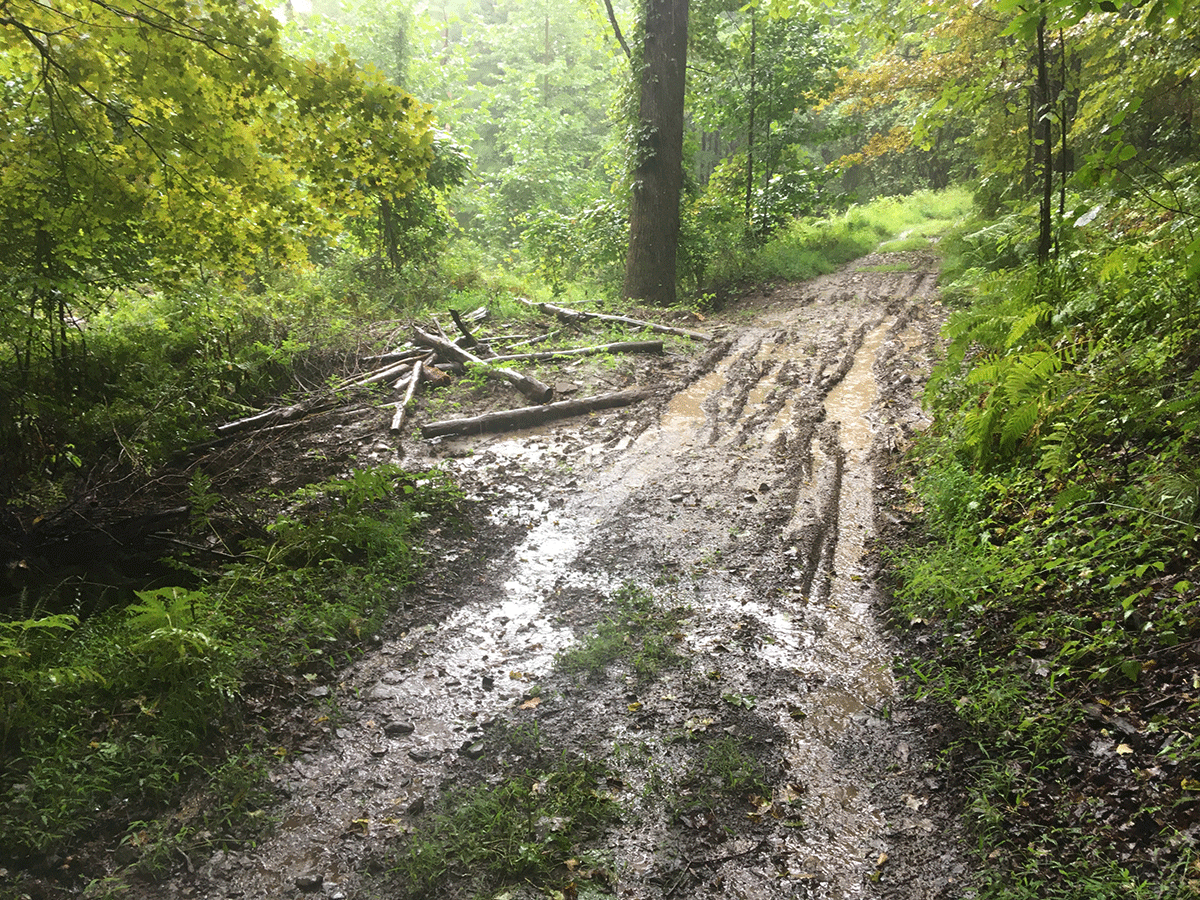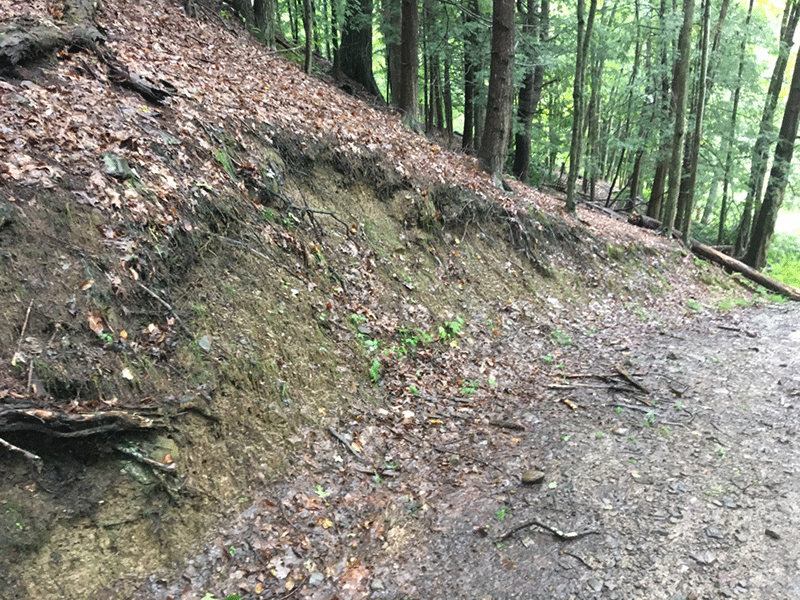Protect the Adirondacks recently visited the proposed multi-use trail in the Sundown Wild Forest in the Catskill Park and a newly recconstructed adjoining trail in the Vernooy Kill State Forest outside the Park. This trail is part of the proposed relocation of the Long Path. Our fieldwork left us with many questions. Tree cutting and trail construction using heavy machinery in the Forest Preserve has begun on this trail. Based on our fieldwork, using maps and materials supplied by the Department of Environmental Conservation (DEC), Protect the Adirondacks does not believe that this project was accurately noticed in the Environmental Notice Bulletin (ENB).
We also have concerns about the compliance of this project with Article 14, Section 1, the forever wild clause in the New York Constitution. The DEC staff has recently stated that it hopes to avoid further litigation over snowmobile trails and Article 14, after the ruling last May that found the DEC violated the forever wild clause in the State Constitution, but its recent actions make us wonder if this is true.
On May 4, 2021, the New York State Court of Appeals, New York’s highest court, ruled in Protect the Adirondacks v. NYS Department of Environmental Conservation (DEC) and Adirondack Park Agency (APA) that these two state agencies violated Article 14, Section 1, the forever wild clause of the State Constitution. In 2013, Protect the Adirondacks launched this lawsuit to challenge the constitutionality of “Class II Community Connector Snowmobile Trails” based on the unprecedented high level of tree cutting and environmental damage to the Forest Preserve’s terrain from extensive grading and flattening with heavy equipment. The first 34 miles of Class II Community Connector Snowmobile Trails (those constructed or approved for construction between January 2012 and October 2014), out of an overall plan to create hundreds of miles of such trails, involved the cutting of about 25,000 trees and the clearing of over 37 acres of forest in the Forest Preserve. The Court found that Class II trails violated the State Constitution.
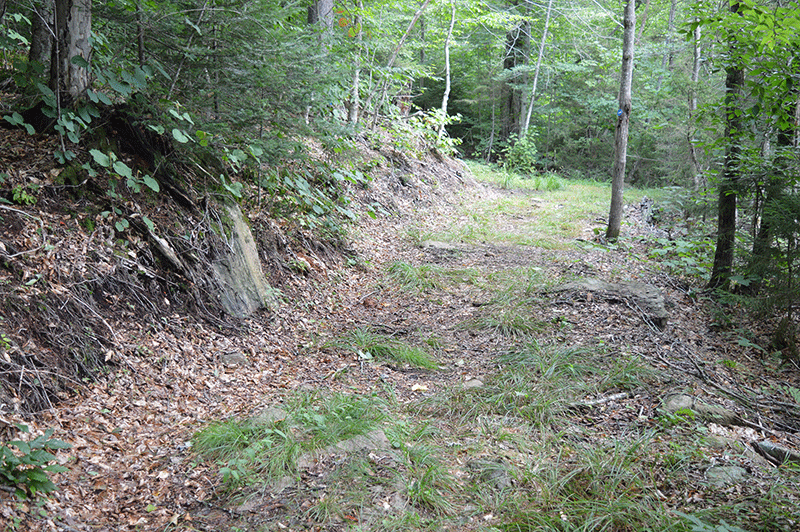
Class II Community Connector Snowmobile Trails were constructed at widths of 9-12 feet, with extensive use of “bench cuts” pictured on the left side of this trail section. Class II trails were found to be unconstitutional.
Since the court’s decision, the DEC has embarked upon a course of action to largely ignore, cherry-pick, and misread the decision. The DEC’s response to the Court of Appeals decision is unfortunate. Part of the DEC’s unfortunate response is its decision to undertake a new project in the Catskill Park to build a wide “multi-use” trail that in many ways is similar to Class II trails.
The ENB Notice for the project states:
ENB Region 3 Notices 7/14/2021, Tree Removal for the Relocation of a Section of the Long Path Trail
The action involves cutting and removal of 1,267 trees three inches or larger in diameter at breast height (DBH) to facilitate the relocation and construction of six miles of new multiple-use trail that will allow snowmobile use during appropriate weather conditions. This project will be completed through an approved work plan and is identified in the approved 2019 Sundown Wild Forest and Vernooy Kill State Forest Unit Management Plan. Trail construction will not exceed standards for Class B trail as defined in Office of Natural Resource Policy #2, Snowmobile Trails – Forest Preserve. Tree cutting will be in compliance with Lands and Forests Policy #91-2 on Cutting, Removal or Destruction of Trees and Other Vegetation on Forest Preserve Lands.
The project is located in the Sundown Wild Forest in the Towns of Rochester and Wawarsing, New York.
Multiple Proposed Routes with Conflicting Length: The DEC Work Plan for this project stated: “This proposed trail reroute would traverse through several miles of State Forest as well as 6 miles of Catskill Forest Preserve lands within the Sundown Wild Forest. The Long Path at this location will be a DEC marked and maintained multi-use trail and will include the use of snowmobiles when conditions are appropriate for use.”
The work plan provided a map that detailed the route, and the DEC staff also provided GPS route coordinates, which I had requested at a Forest Preserve Advisory Committee meeting. In addition, the route was flagged by DEC staff in the Forest Preserve.
Using DEC GPS data, DEC maps, and following flags in the woods set out by DEC staff, our fieldwork found the proposed trail to be 8 miles long. It appears to us that both the Environmental Notice Bulletin (ENB) and Work Plan are incorrect.
At a recent Forest Preserve Advisory Committee meeting, the DEC stated that the new trail through the Sundown Wild Forest will be just like the recently reconstructed trail through the Vernooy Kill State Forest, constructed with a 6-foot trail tread, and up to 8-feet wide on slopes and curves. Our investigation of this new trail found that there were many places that the trail far exceeded the 6-foot and 8-foot trail width limits and that there was extensive benchcutting that gave this trail the practical appearance of a road. If we take state officials at their word and the new trail in the Sundown Wild Forest is to look like the reconstructed road in the Vernooy Kill State Forest we’re in trouble.
Click here to read a detailed letter about the many problems with the new multi use trail under construction in the Sundown Wild Forest.
Click here to read a letter from Protect the Adirondacks to the NYSDEC that details the problems with the state’s response, or lack of a response, to the May 2021 Court of Appeals decision that found that the DEC violated Article 14, Section 1 of the State Constitution.
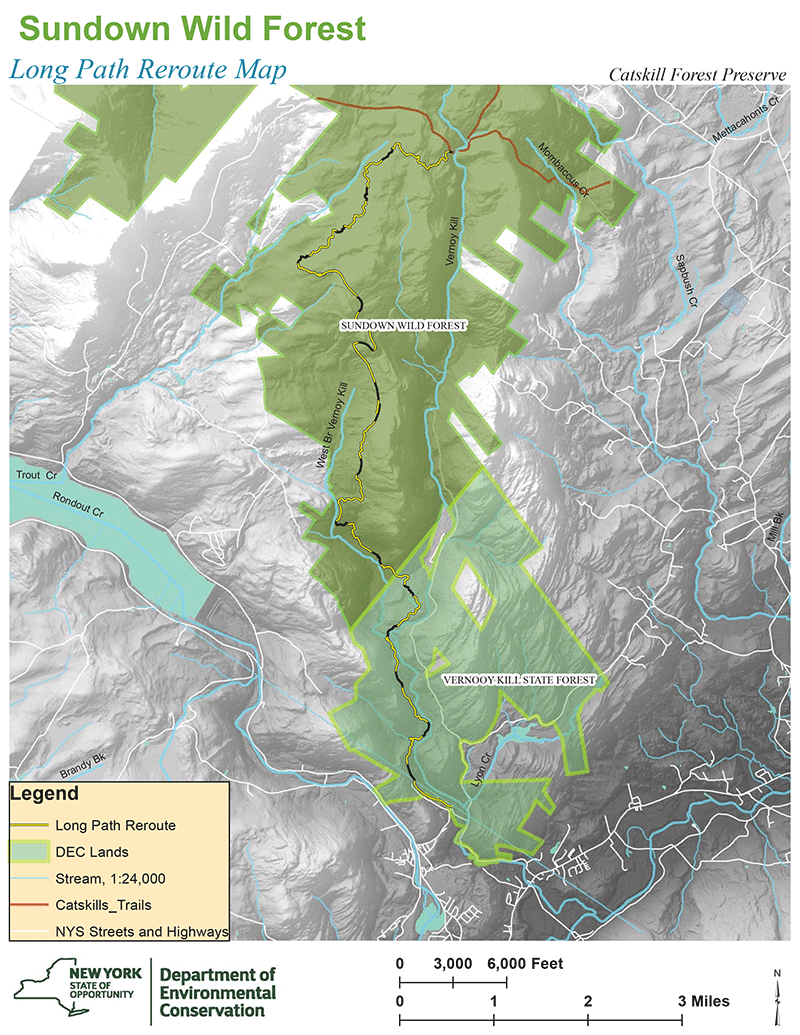
This map shows the route of the recently constructed multi use trail in the Vernooy Kill State Forest and the new multi use trail under construction in the Sundown Wild Area of the Catskill Forest Preserve.
Tree Cutting on the Forest Preserve: The proposed project seeks to cut down 1,267 trees at 3” DBH or greater, as stated in the work plan. The DEC prepared its work plan and counted trees using its tree-cutting policy LF91-2, which only counts trees at 3” DBH or greater. This decision stands in contrast to the string of recent court cases at the State Supreme Court in Albany, the Appellate Division, Third Department, and the Court of Appeals in the Protect case where the courts ruled that cutting 25,000 trees at 1” DBH or greater violated Article 14, Section 1. The DEC’s decision to exclude counts of trees on the Forest Preserve at between 1-3” DBH is inconsistent with the recent court decisions.
In our fieldwork on the proposed new multi-use trail in the Sundown Wild Forest Area, we counted 586 trees between 1-3” DBH at an estimated 6-foot trail width that were not part of the DEC’s count of trees in its work plan. Due to the extent of steep slopes on more than half of the proposed route, along with the number of curves, where the DEC plans to widen the proposed trail to 8 feet, we estimate that the destruction of 1-3” DBH trees will increase by as much as 50%. The total trees on the Forest Preserve projected to be destroyed is likely to top 2,100. This means that at 6 miles in length the DEC will destroy 350 trees per mile. At 8 miles in length the DEC will destroy 262 trees per mile. Tree cutting at this rate is far more than the tree cutting determined by the courts to be permissible in the Balsam Lake decision.
In addition to the destruction of trees by this project, we estimate that at 6 feet in width, with an estimated 50% of the trail built to an 8-foot width, the new multi-use trail will see over 6 acres of forest cleared, where benchcuts are built, rocks and roots removed from the trail, and the trail tread is flattened and graded. The clearing of over 6 acres to build this trail raises serious constitutional questions given the recent Court of Appeals decision, and recent Article 14 amendments for projects as small as 1 acre.
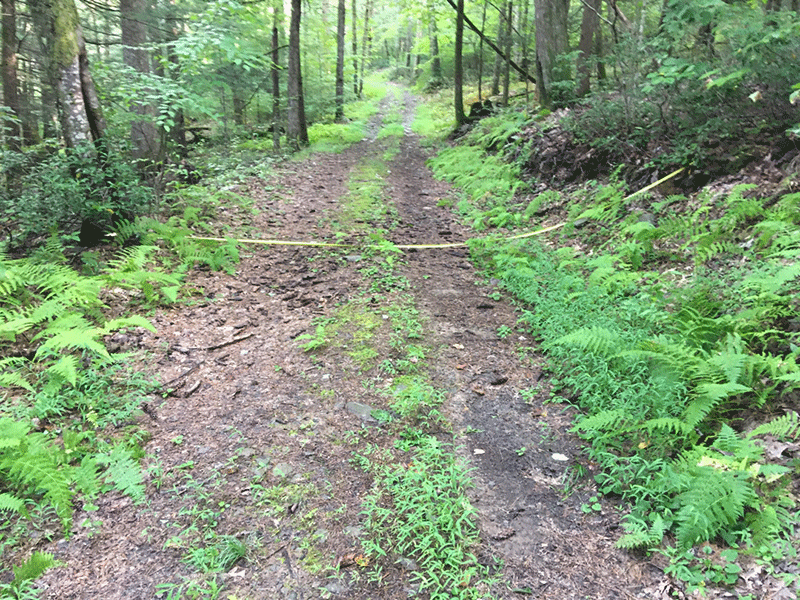
The recently reconstructed multi-use trail in the Vernooy Kill State Forest is more like a road than a trail. This section measured at 15 feet in width from the top of the bench cut to the edge of the disturbed area. The total span of disturbed area to build this trail, which was graded with heavy machinery, was 15 feet wide.
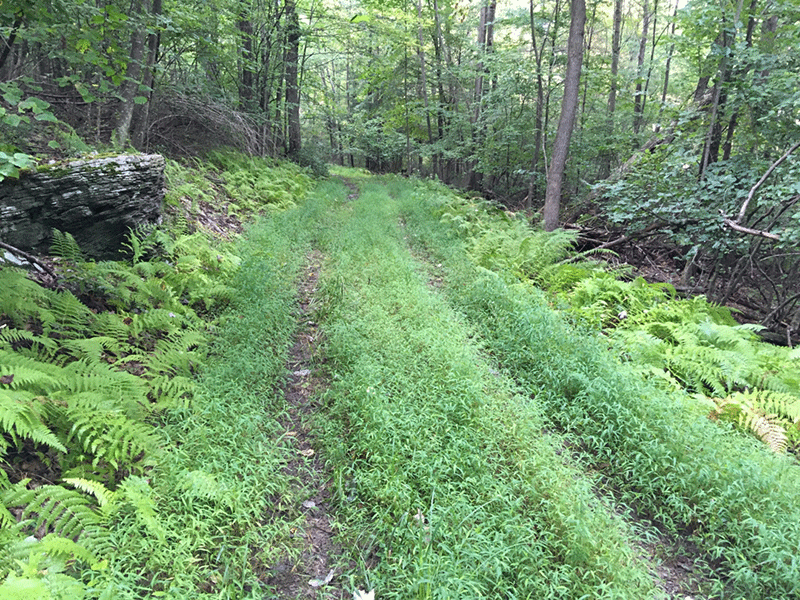
The reconstructed multi use trail in the Vernooy Kill State Forest built by the NYSDEC looks a lot like a forest road.
Compliance with Article 14 Decisions: The newly reconstructed multi-use trail in the Vernooy Kill State Forest saw extensive use of benchcuts, which greatly expanded the disturbed area in many locations. Whereas the DEC stated that the trail tread width on this trail would be 6 feet on flat and straight sections and up to 8 feet on slopes and curves, the reality is that the disturbed area is consistently wider than 8 feet, with many areas seeing 10-foot and 12-foot-wide disturbed areas and wider (as shown above). More than any other feature, benchcuts created during snowmobile trail construction change the character of a trail and the Forest Preserve, making snowmobile trails very different that a foot trail. This fact was noted in the recent Protect decision where the Court of Appeals wrote:
Further, the Class II trails require greater interference with the natural development of the Forest Preserve than is necessary to accommodate hikers. Their construction is based on the travel path and speed of a motorized vehicle used solely during the snow season. The trails may not be built like roads for automobiles or trucks, but neither are they constructed as typical hiking trails.8 Under DEC’s 2009 guidance document, the Class II trails are not to exceed nine feet in width except on sharp curves, steep slopes, and bridges, where a 12-foot width is allowed—the same width as an interstate highway lane and enough to accommodate two SUVs, side-to-side. The proposed bench cuts—cuts into sloped ground and removal of the cut soil, rock and trees to create a “bench” upon which a trail can be placed—require clearing the land on the up- and down-slopes of the trail, resulting in the clearing of the forest floor up to 20 feet in width in certain areas—a span wide enough to site a two-car garage.
The new multi-use trail in the Sundown Wild Forest area will require extensive use of benchcuts due to the many curves and steep slopes.
One of the reasons that the DEC uses to substantiate its need to build a multi-use trail is to provide access. This position was expressly rejected by the Court of Appeals in the Protect decision where it wrote “defendants and the dissent contend that the project’s impacts are justified because it enhances access to the Preserve and provides a variety of recreational opportunities. That analysis proceeds from a fundamental misunderstanding. The constitution provides for access and enjoyment of the Forest Preserve as a wild forest.” We contend that the way in which this new multi-use trail is designed and constructed, in addition to the forest clearing and tree cutting, raises significant issues that we believe violate Article 14. The design and construction methods that the DEC plans to use to construct this new multi-use trail undermines the Wild Forest character guaranteed by the State Constitution.
Extensive Slopes will Require Extensive Benchcuts: The proposed route for the new multi-use trail in the Sundown Wild Forest area traverses terrain with many steep slopes. We estimate that 53% of the proposed route is over grades of 10% or higher. (See the slopes map in this letter.) The proposed route traverses slopes that are 10% grade or less over 47% of the route, slopes between 10-20% grade over 30% of the route, and slopes over 20% on 23% of the route. In areas with curves or steep slopes, the DEC plans to build this trail to 8-feet in width, necessitating greater tree cutting. This trail will also require numerous long benchcuts. The extensive use of benchcuts and the flattening of the trail surface with heavy machinery will result in a trail that is in essence a Class II snowmobile trail. These trails were struck down by the courts in part due to their design. This new trail will be something very different from a foot trail. If the DEC builds this new trail in the Sundown Wild Forest like it recently reconstructed the multi-use trail in the Vernooy Kill State Forest, there will be many bench cut areas that are far in excess of 8 feet in width.
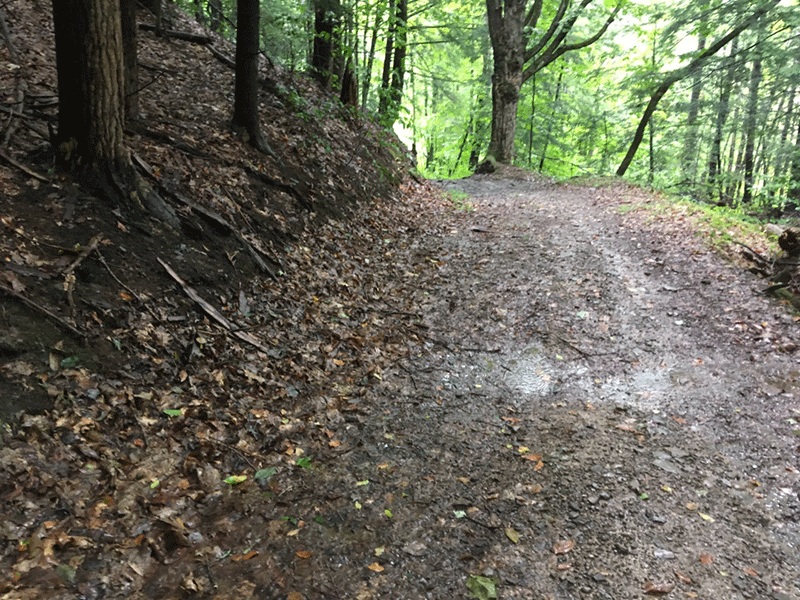
The newly rebuilt multi use trail in the Vernooy Kill State Forest built by the NYSDEC saw extensive use of bench cuts, which introduce unnatural human geometric, commonly used on road projects, into a wild forest setting.
Recent Multi-Use Trail Reconstruction Work in the Vernooy Kill State Forest: At the FPAC meeting on August 26, 2021, DEC staff stated that the new multi-use trail through the Sundown Wild Forest area would be constructed the same way as the reconstructed multi-use trail through the Vernooy Kill State Forest, which will link with the new trail. The work plan for the Sundown Wild Forest trail states: “In terms of width, the treadway width will generally be 6’ wide with some sections up to 8’ in width where necessary for turns and sections of steeper cross slope.”
Our fieldwork on the Vernooy Kill State Forest trail found this trail to be something very different from a foot trail. In many places, the trail tread exceeded 8 feet and large benchcuts saw clearing well outside the 8-foot trail tread. The pictures on this page show benchcuts that widened the trail to widths of 10 feet and wider in many locations. If the DEC plans to build the multi-use trail in the Sundown Wild Forest using the same general design and oversight as the trail built through the Vernooy Kill State Forest, we have little confidence that the DEC will adhere to the required limits, and instead will regularly disturb areas beyond 8 feet.
New Trail in Sundown Wild Forest Does Not Comply with DEC Policy ONR-2: ONR-2 states “Care should be taken to designate separate areas for incompatible uses such as snowmobiling and ski touring or horseback riding and hiking.” Yet, despite this directive in ONR-2, the DEC is planning a multi-use trail in the Sundown Wild Forest. The decision to include snowmobiling on this multi-use trail will result in many changes to this trail that make it something entirely different from a foot trail or a mountainbike trail. Further, this trail is not on the periphery of the Forest Preserve, but runs through the heart of this Wild Forest unit.
The design conditions to support snowmobiling include the 6- to 8-foot trail tread widths at many points due to extensive slopes on the trail route. Large rocks and roots will be removed from the trail tread area. The trail tread will be flattened by grading with heavy machinery. The trail will see extensive use of benchcuts on one or both sides of the trail, which introduces human geometric shapes to an otherwise wild forest atmosphere. The benchcuts will also result in disturbed trail widths far wider than 8 feet, where widths of 10-20 feet will regularly occur. These construction methods are being used solely to accommodate snowmobiling, which is not a significant recreational use in the Catskills, and will undermine the foot trail experience and enjoyment for hikers and mountainbike riders. These multi-use trail construction methods are no different than those used to build the Class II trails that were found to be unconstitutional in the Protect case.
It’s also important to point out that ONR-2 does not provide any guidance for benchcuts, rock removal, root removal, and trail tread flattening and grading. These are staples of snowmobile trail construction that were omitted from ONR-2.
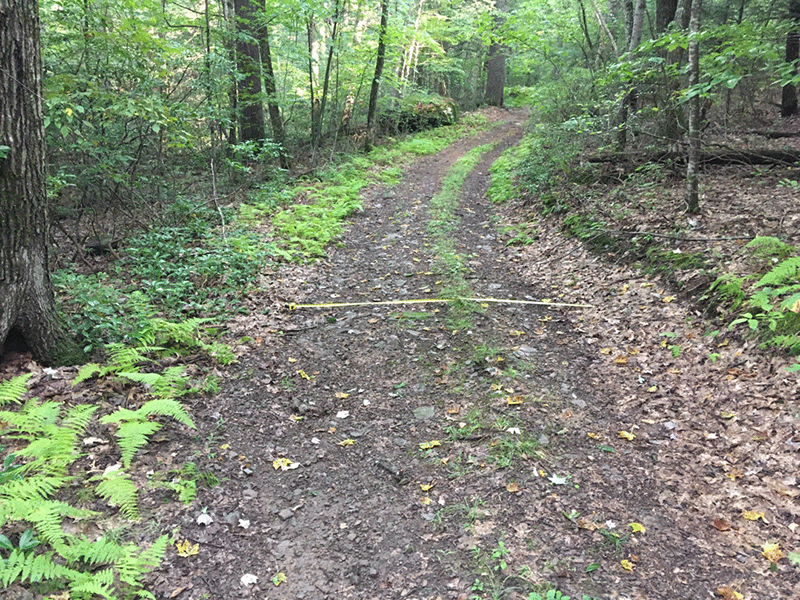
This picture shows a measuring tape at 8 feet. There is disturbed area at both ends that far exceeds the area that was supposed to be disturbed.
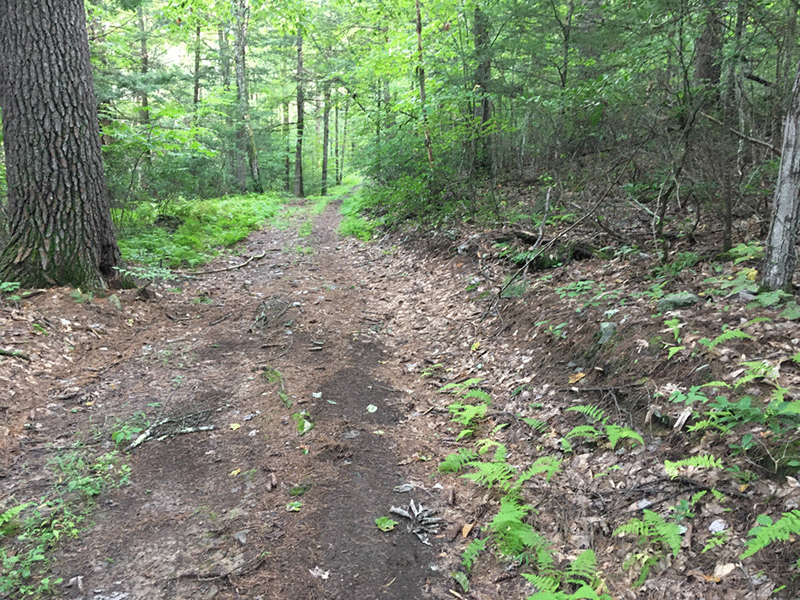
Another very wide section, well over 8 feet in width, due to the extensive use of bench cuts and grading to create a flat and wide trail.
Existing Snowmobile Trail Poorly Maintained, Unrideable For Snowmobiles in Locations: The existing trail from Yeagerville to Vernooy Falls, which the new multi-use trail links to, is not a viable snowmobile trail in its current condition. The trail is poorly maintained and has many sections where trees and shrubs prevent snowmobile use. While this trail has long been marked as a snowmobile trail, it clearly has not seen much, if any, snowmobile use in recent years. The major presence of large rocks along the trail will require significant snowfall to make this trail marginally passable in limited sections. This trail may be a snowmobile trail on paper, but the realities on the ground make this trail unusable for modern snowmobiling.
The Long Path Deserves Better: While we see the merit and importance of moving a long stretch of the Long Path from a road walk to the State Forest and Forest Preserve, we see the decision to build a multi-use trail as a means of re-routing the Long Path as a missed opportunity. If the new trail in the Sundown Wild Forest is built in any way like the new trail was built in the Vernooy Kill State Forest the experience of the Long Path will be greatly diminished. What could have been a beautiful hike through beautiful wild country will be undermined by a wide multi-use trail that is far more akin to a road than a hiking trail. A beautiful narrow foot trail should have been constructed for the Long Path, but the public hiking experience was sacrificed for expansion of motor vehicles into a part of the Forest Preserve where they simply do not belong and makes no practical sense.
Protect the Adirondacks urges the DEC to halt its plans to build this new multi-use trail in the Sundown Wild Forest Area in the Catskill Park given the incorrect ENB notice and the constitutional questions that surround it.
To date, the DEC has stated that not has no plans to stop this work in the Catskill Park and remains committed to building a network of wide snowmobile trails in the Adirondack Park and Catskill Park to criss-cross the Forest Preserve.

